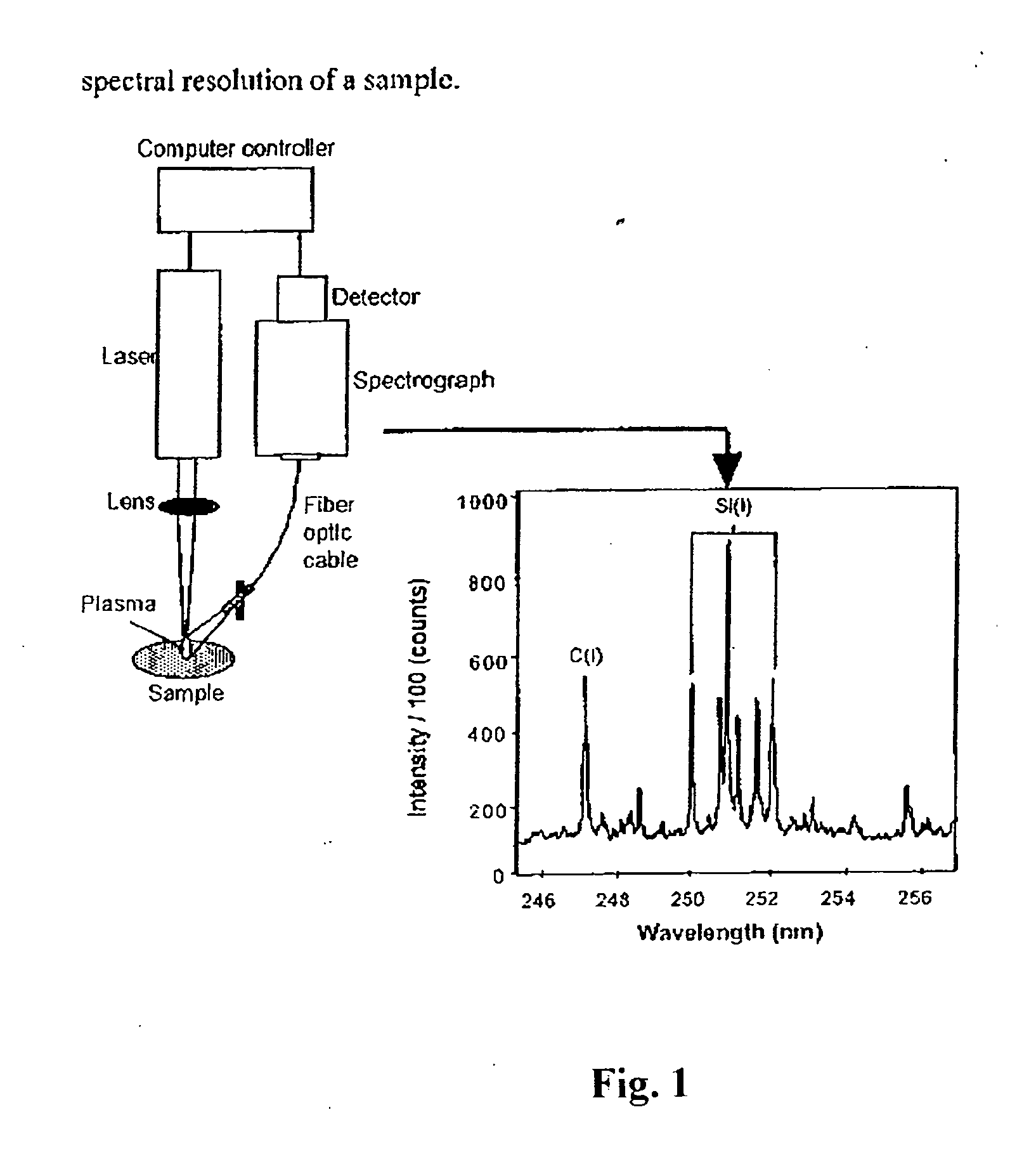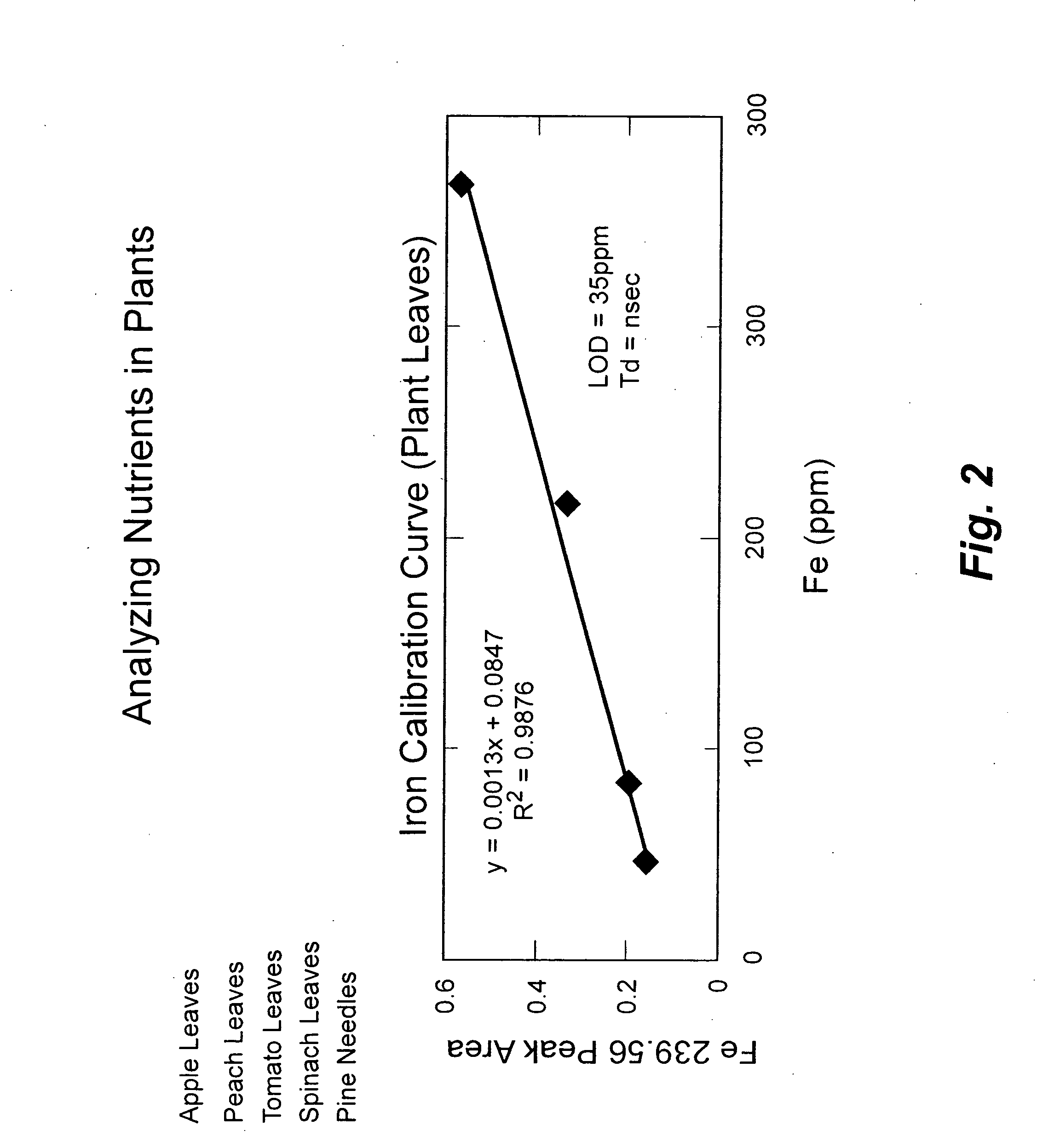Measuring nutrients in plants and soils by laser induced breakdown spectroscopy
a technology of nutrient breakdown and laser induced spectroscopy, which is applied in the field of nutrient analysis systems using laser induced breakdown spectroscopy, can solve the problem that extraction techniques generally require tedious techniques
- Summary
- Abstract
- Description
- Claims
- Application Information
AI Technical Summary
Benefits of technology
Problems solved by technology
Method used
Image
Examples
example 1
[0039] Various plant leaves (apple, peach, tomato, spinach and pine needles) with known levels of targeted species were obtained from the National Institute of Standards and Testing (NIST) standard reference materials, e.g., apple leaves as NIST-SRM 1515, peach leaves as NIST-SRM 1547, tomato leaves as NIST-SRM 1573a, spinach leaves as NIST-SRM 1570a and pine needles as NIST-SRM 1575a. Leaves were measured for calcium, potassium, iron, sodium, strontium and barium using a Spectrolaser 1000HR (XRF Scientific). The particular LIBS instrument generated the necessary bright spark or plasma at the sample, the emission or light from which was subsequently analyzed by a spectrometer and detection system. An argon purge of the container volume containing the sample was carried out to improve sensitivity. Calibration curves were plotted from the standard samples and the particular curve for iron is shown in FIG. 2. Calibration curves were plotted from the standard samples and the particular ...
example 2
[0041] Sample soils were spiked with a general fertilizer (Miracle Gro® All Purpose Plant Food), a lawn fertilizer (Turf Builder® Lawn Fertilizer), or sulfur. The respective soils were then analyzed by first drying and then pressing into a pellet. Subsequently, each pellet sample was measured for potassium, nitrogen or sulfur in the manner of Example 1 except that a more sensitive LIBS instrument was used including a 0.5 m focal length spectrograph (Chromex Imaging Spectrograph, Model 500IS) a gated intensified charge coupled device (ICCD) detector (Oriel, Instaspec V). Also, an argon purge of the sample container volume was used in the measurement of nitrogen levels in the soil to avoid complications from the nitrogen in the air to the measurement level. The emission or light was analyzed by a spectrometer and detection system.
[0042] Calibration curves were plotted from the spiked samples and are shown as FIG. 4 (for phosphorus), FIG. 5 (for nitrogen) and FIG. 6 (for sulfur).
example 3
[0043] Sample synthetic silicates (soil-like samples from Bremer Standard Online Catalog, Houston, Tex.), spiked with a general fertilizer (Miracle Gro® All Purpose Plant Food) or a lawn fertilizer (Turf Builder® Lawn Fertilizer), were analyzed in the manner of Example 1 using a Spectrolaser 1000HR (XRF Scientific). The respective soils were then each analyzed by first drying and then pressing the material into a pellet. Subsequently, each pellet sample was measured individually for manganese, zinc, copper, chromium, lead, barium, strontium and vanadium.
[0044] Plots of the spectra were plotted from the spiked samples and are shown as FIG. 13 (for manganese), FIG. 14 (for zinc), FIG. 15 (for copper), FIG. 16 (for chromium), FIG. 17 (for lead), FIG. 18 (for barium), FIG. 19 (for strontium), and FIG. 20 (for vanadium).
PUM
 Login to View More
Login to View More Abstract
Description
Claims
Application Information
 Login to View More
Login to View More - R&D
- Intellectual Property
- Life Sciences
- Materials
- Tech Scout
- Unparalleled Data Quality
- Higher Quality Content
- 60% Fewer Hallucinations
Browse by: Latest US Patents, China's latest patents, Technical Efficacy Thesaurus, Application Domain, Technology Topic, Popular Technical Reports.
© 2025 PatSnap. All rights reserved.Legal|Privacy policy|Modern Slavery Act Transparency Statement|Sitemap|About US| Contact US: help@patsnap.com



